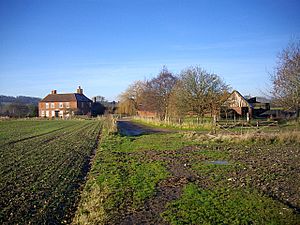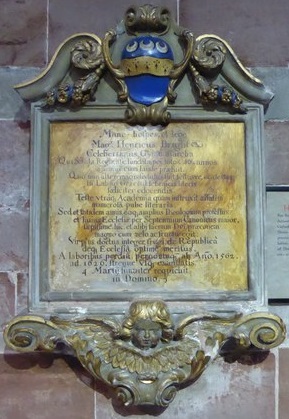Henry Bright (schoolmaster, born 1562) facts for kids
Henry Bright (born 1562, died 1627) was an important clergyman and schoolmaster in Worcester. He was the Headmaster at The King's School, Worcester for 38 years. Famous writers like Thomas Fuller and Anthony Wood said he was an amazing teacher. He was especially good at teaching Latin, Greek, and Hebrew. Many of his students became well-known for their skills in Latin and Greek, and they had a big impact on religious topics.
Contents
Henry Bright's Life and Work
Henry Bright was born in Worcester and was baptized on October 26, 1562. He was the oldest son of James Bright.
He likely went to King's School, Worcester himself. Later, in 1580, he went to Brasenose College, Oxford when he was 18. He then moved to Balliol College, Oxford. He earned his first degree (B.A.) in 1584 and his master's degree (M.A.) in 1587. In 1585, he was chosen to be a fellow at Balliol College.
Bright started working at King's School, Worcester, in 1589. He also held several jobs in the church. These included being the rector (main priest) of Broadwas (1591), Tredington (1606), and Warndon (1615). He was also a canon (a type of priest) at Hereford Cathedral (1607) and Worcester Cathedral (1619).
In 1609, he bought a large piece of land called Brockbury in Colwall, Herefordshire.
Henry Bright passed away on March 4, 1627.
Thomas Fuller, in his book History of the Worthies of England, praised Bright. He wrote that Bright was placed in Worcester so he could share his knowledge of grammar with students from both England and Wales. Students from Wales did indeed attend his school. Bright also arranged for Worcester Cathedral chapter to give small scholarships (called "exhibitions") to students he sent to university.
Anthony Wood also spoke highly of Bright in his book Fasti Oxoniensis. He said Bright was excellent at teaching Latin, Greek, and Hebrew. Many of his students went to universities and became very successful. Wood also mentioned that Bright was a great preacher, and people came from far away to hear him.
Bright Family History
Family Symbol (Arms)
The Bright family had a special symbol, called "arms." It showed a blue shield with a wavy white stripe across the middle. Above the stripe were three silver crescent moon shapes.
Marriages and Children
Henry Bright was married twice. His first wife was Maria Tovey. They had one daughter:
- Mary Bright
His second wife was Joan Berkeley. She was the daughter of Rowland Berkeley and the sister of Sir Robert Berkeley, who was a judge. Henry and Joan had one son and three daughters:
- Robert Bright (1617–1665), who inherited the family estate
- Dorothy Bright
- Joyce Bright, who married John Brydges
- Catherine Bright
Robert Bright inherited the Brockbury estate. It stayed in the Bright family for many centuries. Later, it passed to Henry Bright (1784–1869) and then to the historian James Franck Bright (1832–1920).
Henry Bright's Memorial
You can still see Henry Bright's memorial on a wall in Worcester Cathedral. It has a special message, called an epitaph, written in Latin by Joseph Hall. Hall was the Dean of Worcester at the time. Here is what the epitaph says:
| Mane, Hospes, et lege. | Stop, stranger, and read. |
| Magister Henricus Bright, | Mr. Henry Bright, |
| celeberrimus Gymnasiarcha, | The most famous schoolmaster, |
| qui Scholae Regiae istic fundatae | Who was in charge of the Royal School here, |
| per totos quadraginta annos summa cum laude praefuit : | For 40 years in total, with great praise. |
| Quo non alter magis sedulus fuit scitusve aut dexter | No one else was more hardworking or wise or skilled |
| in Latinis, Graecis, Hebraicis Literis feliciter edocendis : | At successfully teaching Latin, Greek, and Hebrew. |
| Teste utraque Academia, quam instruxit affatim numerosa pube literaria ; | Both universities can prove this, as he sent them many learned young people. |
| Sed et totidem annis coque amplius Theologiam professus, | Also, for as many years and more, he taught theology, |
| et hujus Ecclesiae per septennium Canonicus major, | And for seven years he was a main canon of this church. |
| sepissimè hic et alibi sacrum Dei Praeconem magno cum zelo et fructu egit ; | Very often, here and elsewhere, he preached God's word with great passion and success. |
| Vir pius, doctus, integer, frugi, de Republicâ deque Ecclesia optimè meritus, | A good, learned, honest, and careful man, who served both the country and the church very well. |
| à laboribus perdiu pernoctuque ab anno 1562 ad 1626, | From his hard work day and night from the year 1562 to 1626, |
| strenue usque extant latis, 4to Martii suaviter requievit in Domino. | After working tirelessly, on March 4th, he peacefully rested in the Lord. |
Famous Students of Henry Bright
Henry Bright is mostly remembered for the many students he taught at Worcester. He often sent them to Oxford University, and many of them became very well known. Some of his notable students include:
- John Beale, a clergyman and science writer. Bright helped him become interested in the ideas of Erasmus.
- Samuel Butler, a poet and writer of funny stories, who wrote Hudibras.
- John Doughtie, a canon at Westminster Abbey, where he is buried.
- William Dugard, a schoolmaster and publisher who worked with John Milton.
- Thomas Good, who became the Master of Balliol College, Oxford.
- Thomas Hall, a minister who was removed from the Church of England in 1662.
- Robert Harris, who became the President of Trinity College, Oxford.
- Roger Maynwaring, who was the Dean of Worcester and later a Bishop. He was also a chaplain to King Charles I.
- Thomas Nabbes, a writer of plays.
- Hannibal Potter, who became the President of Trinity College, Oxford.
- Francis Potter, a writer about the Bible and a science innovator.
- Sir John Vaughan, a judge and statesman, who was the Chief Justice of the Common Pleas.
- Thomas Warmestry, who became the Dean of Worcester.
- Edward Winslow, one of the Pilgrim Fathers who sailed to America. He became a Governor of Plymouth Colony in Massachusetts.




